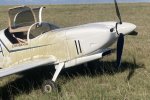Definitely worth practicing engine out landings from cruise altitudes all the way to the runway. might need to pick a rural airport to make that happen, because coming in from 5 miles away simulated engine failure it is hard to fit into the pattern of a busy airport. But it’s a teachable and also a perishable skill. Which explains sometimes why student pilots losing an engine solo do better than 20 year pilots. Most importantly, realize that if you do lose your engine and you land almost anywhere under control, you will survive, there are 2 to 3 forced landings every day, the vast majority of them never get reported. The NTSB will never put them in the database if there’s no significant injury or damage, which is the usual case. I tried to study this for the better part of a year with the hope of actually coming up with some real data. By searching nationwide news reports, the AIN, and tips from friends and family I amassed quite a database. My plans were to stratify, according to landing site, airplane type, stall speed, cause of the forced landing and all of that. All of that was thwarted by the fact that I realized unless there was serious injury or damage the NTSB never published a report. So I had a lot of basically useless data.
But my take away of that was it around 96% of forced landings were survivable, most with no or little injury. The ones that were fatal, were almost always stall spins, the pilot obviously trying not to hit the ground. One of the most deadly FAA hazardous attitudes which people spend the least time on, is the hazardous attitude of resignation. It goes something like, oh God I lost my engine, I’m going to die, nothing I can do now…. CRASH. That is because we’ve been taught by other pilots, instructors, the media that engine outs are highly fatal. When in fact, they are highly survivable. We can do it to our fellow pilots in an insidious way. One of our friends lands engine out, is not injured, and we say oh man, you were lucky. When in fact, if you look at the data if he/she were seriously injured, they would be unlucky, as the expected result is he/she is not going to be seriously hurt, if they just don’t stall.
So, just don’t stall, fly the plane all the way until it stops, aim for the softest spot you can find. Statistically, you will be fine.


